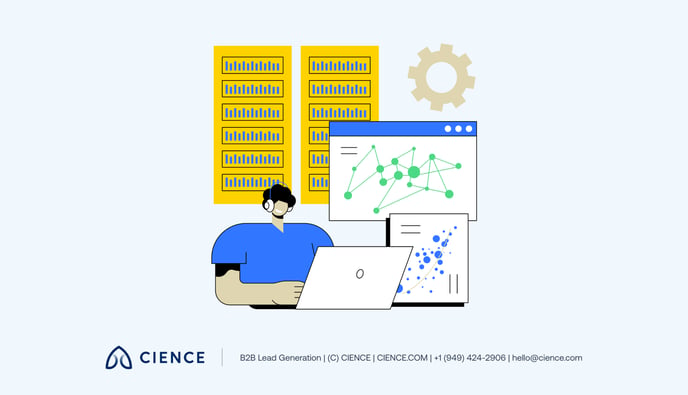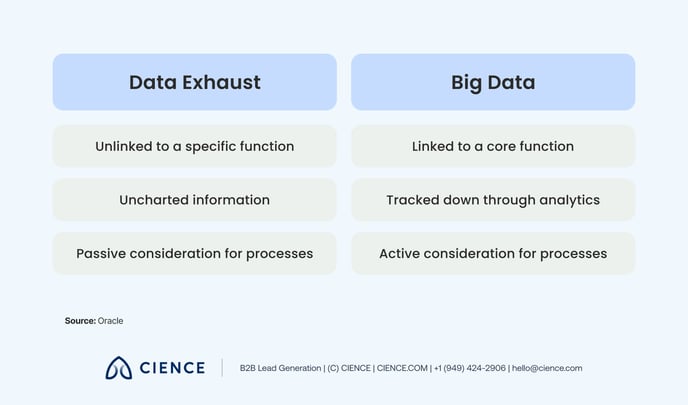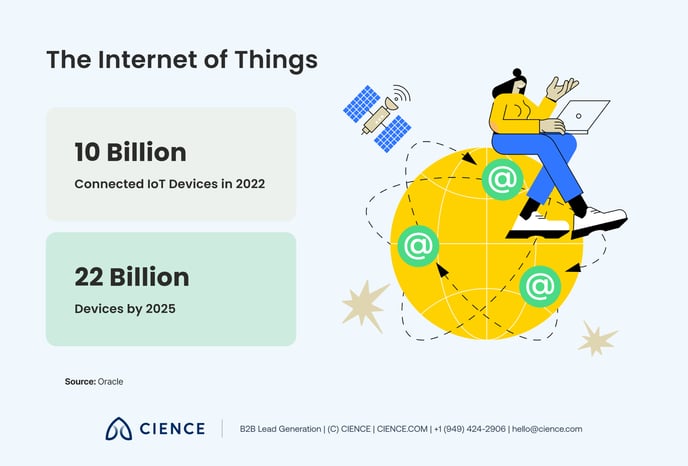What Is Data Exhaust and How to Use it for Business
Data is the fuel that pumps the engines of B2B companies, driving them into new, faster, and cleaner tracks. With all the current possibilities to generate high-quality leads, many businesses rush their sales processes not aware of all the data value that is being lost along the way. When used wisely, data exhaust can help businesses propel their revenue through more precise decisions.
While business data has been a prominent currency for over a decade, data analytics played a crucial role in withstanding the effects of the COVID-19 pandemic. This unexpected turn led 94% of business analytics professionals to claim that analytics are critical to their organization’s digital transformation programs, and 32% of companies altered longer-term strategies in response to insights brought about by data.
However, we are still miles away from effectively employing the raw force of data exhaust. Cody Young, Head of Data Strategy at CIENCE, shared that one of the biggest challenges in B2B marketing, both inbound and outbound, is to work with complete, high-quality fresh data: “The bottom line is that the only way to have quality data is to use it to know more about the person on the other side of the screen.”
If B2B marketers, decision-makers, and sales reps desire to take full advantage of the wild yet rich information offered almost involuntarily by possible clients, the data exhaust concept must be understood at a deeper level. Let’s dive in.

What Is Data Exhaust?
Data exhaust can be understood as the result of every single online action deployed by a user. Also known as a data trail, some data exhaust examples include log files, cookies, temporary files, and even stored information for every digital transaction. This data can create quite a rich user profile, making it extremely important to researchers, marketers, and businesses in general.
This data can be used to target several types of ads to specific preferences, habits, demographics, behaviors, and many more traits of potential customers, giving companies accurate insights so they can mold their business into something that the people will consume at the end of a sales funnel.
This makes data exhaust sound like a delicious fruit B2B marketers can just rip off a tree. The truth is far more complex. A colossal amount of information needs to be dissected to access the insights, strategies, and recommendations that companies hunger for. Unfortunately, many of them don't possess the proper infrastructure to take on such a heavy load of knowledge and transform it into actions.

The Importance of B2B Data Exhaust
Data exhaust B2B sales and data exhaust B2B marketing teams need to understand that they are working with very delicate information. Although databases are legally obligated to confirm that they might use the shared data for commercial purposes, many users still get astonished every time a direct message (DM), email, or cold call feels too personal.
Cody Young explains: “The brass ring is the experience you have with each record that you are using in any kind of the campaign. The exhaust is the means by which we come to understand the digital footprint of the person.”
It is when enterprises begin to flood in unused or outdated data that they go into purge mode, not knowing or caring for the discarded raw material's value. For this reason, data-driven organizations constantly rely on big data and the internet of things (IoT) analytics to ensure that they are taking advantage of as much data as possible. Let's take a better look at each concept.
What Is Data Exhaust vs. Big Data?
Big data refers to data sets that are too vast, fast, and complex for the traditional data processing software. Oddly enough, those last words could also make a fine data exhaust definition, except for one not-too-small detail: Big data has been already adjusted into a specific correlation with a core function of a business while data exhaust is every other data footprint that was created as a result of all online activity.
This means data exhaust is way bigger than big data, as awkward as that may be. Let's illustrate this disparity even further: For a bank, big data could translate into all the information related to debits and credits to its customers' accounts. This can involve the type of cards used whether it's a Visa/Mastercard credit card, a student debit card, a virtual gift card, or the prepaid ones will all be collected. In the same scenario, data exhaust would concern the percentage of customers' transactions done at an ATM instead of a physical branch.
Other examples of processed data could include how many times per month customers used the bank’s digital app, what were the rush hours, and which actions were the most requested. This information would be highly relevant if the bank wanted to upgrade its app’s UX, but it might go unnoticed in case this is not a top-priority goal.

Despite these extremely relevant differences, especially when it comes to how to get the most value out of data in the shortest time, both data exhaustion and big data share very meaningful characteristics:
- Volume: Low-density, unstructured data in high volumes are to be expected with both terms. Clickstreams on a web page or a mobile app, or sensor-enabled equipment, are just a couple of data sources that could inject hundreds of petabytes into a company's servers within a few minutes.
- Velocity: This is the rate at which data is received and, sometimes, processed. Some internet-connected smart devices function in real-time or near-real-time, requiring immediate evaluation and action.
- Variety: This attribute points out the many types of data available. Text, audio, and video are the most common formats, but they could require additional preprocessing depending on the meaning they aim to support.
And just to overheat the rivalry between this pair of data siblings, both were put in the race to predict the user's behavior out of a trending technology that keeps on winning new admirers: the Internet of Things (IoT).
Data Exhaust and the Internet of Things (IoT)
The arrival of new technologies also means that increasingly creative and complex data trails are within reach. And although it cannot be claimed that the Internet of Things is a newcomer in the B2B arena, its most recent implementations are giving companies a lot to talk about.
The concept of the Internet of Things (IoT) wasn’t officially used until 1999, but early experiments go back to the early 1980s. A Coca-Cola machine was placed at the Carnegie Mellon University and, according to a Dataversity entry, some local programmers connected the vending machine to the Internet so they could check if there were cold cans available.
Since that day, data scientists and engineers have been working hard to ingrain multiple “things” with sophisticated sensors that, alongside their software counterparts, can collect and share data with internet-connected devices to produce an exquisite data exhaust source with minimal human intervention.
Oracle reports that there are about 10 billion connected IoT devices to the present day, and data experts predict that this number could rise to 22 billion internet-connected things by 2025.

The smart objects list goes wide and far: From everyday objects—like kitchen appliances, security systems, fridges, baby monitors, and even sneakers—to the most advanced industrial gear.
Capture and analyzing business data has never been easier in the history of mankind, and now that we have gone through the most characteristic subjects associated with data exhaust, the time has come to convert this massive stream of information into the concentrated drops of fuel that will help your company's revenue soar.
How to Use Data Exhaust for Your Business
Without a doubt, data exhaust could become a company's best ally or its deadliest distractor, as Young points out: “It's all a matter of how capable you are in sorting the wheat from the chaff.”
However, businesses can learn how to use data as a competitive advantage if they have the willingness, the knowledge, and the resources to process this raw oil into pure fuel. In other words, data exhaust can be tamed.
While the procedure of dissecting data trails could slightly change depending on the industry, here are five steps you should take to control data exhaust:
1. Understand your data sources.
Data is flowing down your company every moment, and only you and your data research team are responsible for what to do with it. To prevent being drowned by the data stream, it is important to identify where, when, and how data is entering your CRM.
As its name suggests, a data source is an initial location where data is born. It can either be physical information that has been digitalized, the moment when a digital user accepts a cookie, the filling of any type of digital form, or even someone clicking on an ad from a certain social media. It is important to note that your business must have a carefully crafted policy that states what personal data you plan to gather from users. A cookie consent platform can be used to create a policy and customize your cookie banner, which allows users to deny or accept your request to store any of their personal data, in order to make data-driven decisions.
The most common data source types are:
- Databases
- Flat files
- Web services
Discover which channels your potential leads are using to interact with your brand, analyze the most crowded times and preferred ways to make contact, identify the kind of data these contacts are leaving at your door, and you will have built a clean platform so your data may land without inconveniences.
2. Define what you aim to measure.
“Measure what matters and you'll be halfway there,” suggests Young. Once you have identified the types of information sources your company has, it is time to decide which elements your analysts want to focus their attention on.
The variables are almost infinite. Without any sort of order, data will keep on swirling indefinitely, piling up in databases that could be left stacked in a dark corner of your CRM. Who can take on this insolent data chaos and turn it into practical actions? Well, only you, of course. And the best way to do so is by understanding this data outcome into quantifiable means. Here are a few examples of how to do so:
- Decide what you want to know: Any serious B2B marketing team already has decent insights into both pain points and passion points involved in the different processes of the organization. From constant dropouts in a certain stage of a sales funnel to unwanted leads popping up at an unusual scale, use these events as a compass to elaborate on the questions that need answers.
- Establish your metrics: Metrics are the measurement standards that can be used to track and assess the progress of different business processes. They will help you have a clear view of the spent budget, total revenues, and overall progress of short-term and long-term goals. Let your metrics become the backbone of your data exhaust strategies.
- Narrow down your KPIs: A key performance indicator is a measure of performance that can easily evaluate specific objectives over time. B2B sales teams should use KPIs to define their goals, determine their progress, and keep on improving the lead conversion process. Build strong data-based KPIs to grow your team's productivity.
NOTE: Even when you have already decided on the type of data that seems most relevant to meet your research objectives, try not to discard less-fitting databases too quickly. New research approaches may emerge in the future, and data that seemed useless today can become transcendent tomorrow.

3. Select the right tools.
Now that your data sources are all pinned down, and you and your sales team already handpicked the questions that need to be answered, it is time to gear up the instrumentation that will be able to collect, organize, and store your data.
The list of data enrichment tools is wide, and deciding which is the best option will depend on factors such as the size of your company, the amount of data you want to work with, and your budget.
Most options offer monthly subscriptions, annual billing, and trial periods. Their services tend to include API components for advanced customization, automated data integration from various data sources, data handling, and report creation platforms. Some of the top-notch data tools on the market include:
This list wouldn't be complete without fully going into CIENCE GO Data, a unique sales intelligence platform that is able to manage more than ten million leads and data points stored in its dataset. It also contains over 300 million records spanning all industries and offers a complete picture of the targeted prospects.
If this is the first time your company is integrating such technology, it is highly recommended to do some research about the pros and cons of each tool, and maybe play for a bit with the free options available. Again, the right platform will depend on the type, amount, and applications of the data you want to work with, so take your time to make the right decision.
4. Harvest the findings.
Suddenly, data exhaustion no longer looks that lawless. To this point, you should have successfully managed to establish an order for that monstrous mass of information, and thanks to the analysis tools you are working with, you can even visualize it through graphs, spreadsheets, infographics, comparative tables, and other reading formats that allow you to interpret your data with total clarity.
Now it's finally time to turn this knowledge into practical insights that will grant stability to your business's wheel. Nevertheless, this step could be more complex for some companies. You will need to work with a team of first-class data scientists, engineers, and other specialists that will be able to pin the hidden patterns in your contact's data trails.
In case you don’t have an inner team that can focus exclusively on juicing data, you can always outsource this task to a company that specializes in data solutions. This way, your business can concentrate on what it does best while the outsourced team supplies it with clean, direct, and applicable data-based proposals that can help you get the answer to your questions.
5. Apply the knowledge.
Last but not least, and maybe the most important action in this shortlist of actions to take advantage of data exhaustion, is to listen to the insights. Strategies based on data analysis are as straightforward as they get. It's not always easy to face all the changes that need to be done to improve your business.
According to a NewVantage report, only 24% of companies that participated in the 2021 survey have developed into data-driven businesses. This is understandable for the restructuration actions sometimes mean rethinking all the present strategies, being more strict with employee performance, and in the most extreme cases, rewriting the business model from scratch.
Change is not always easy, but data exhaust analytics tend to be a reliable guide toward the constant improvement of companies. Once your workforce is trained, the required transformations are made, and the insights are set in motion, your data-optimized engine will take your business as far as you want it to go.

Utilize Your B2B Data Exhaust
"The more ways you can understand somebodies digital behavior, the richer the exhaust is,” says Young. Collecting, optimizing, and implementing data is a never-ending work in progress. The good news is that more sophisticated platforms, validated strategies, and creative solutions keep getting more accessible for all-sized B2B companies as time flows.
Even data-analytics companies are deciding to join in, creating networks of data bridges that could help both public and private organizations to have a high-definition picture of the people they work for by subtracting layers of uncertainty in their everyday choices, making it easier for everyone to solve their needs through fewer moves.
B2B companies that don't allow themselves to become data-oriented will soon discover that the familiar roads that drove them into their high-quality leads cease to be efficient. And while businesses need to prepare themselves to embrace this almost-evolutionary process, they just have to remember that the knowledge is already at their fingertips. All they have to do is grasp it.
A Few (Related) Sales Posts
 Read full post: How to Build a Content Strategy to Attract B2B Decision-Makers
Read full post: How to Build a Content Strategy to Attract B2B Decision-Makers
How to Build a Content Strategy to Attract B2B Decision-Makers
 Read full post: 5 Ways to Engage B2B Customers With Omnichannel Outreach
Read full post: 5 Ways to Engage B2B Customers With Omnichannel Outreach
5 Ways to Engage B2B Customers With Omnichannel Outreach
 Read full post: 4 Ways to Improve Customer Relationships in the B2B Sales Process
Read full post: 4 Ways to Improve Customer Relationships in the B2B Sales Process
